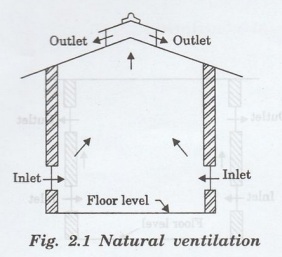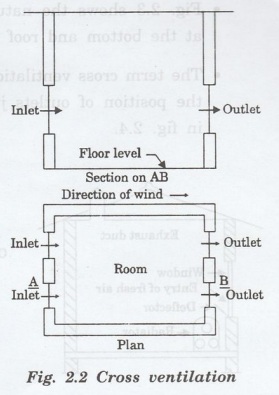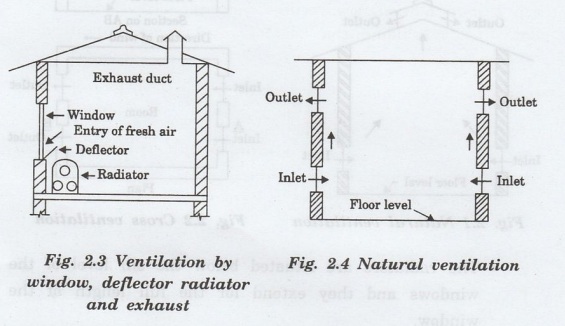Physics For Civil Engineering: Unit II: Ventilation And Refrigeration
Principles of Natural Ventilation
In this system of ventilation, doors, windows, ventilators and skylights are used to make the room properly ventilated. This system is useful for small buildings.
PRINCIPLES OF NATURAL VENTILATION
1. Natural Ventilation
In this system of ventilation, doors,
windows, ventilators and skylights are used to make the room properly
ventilated. This system is useful for small buildings. But, it cannot be
adopted for big offices, theatres, auditoriums, etc.
The advantage of this system is it's
economic, because, no special equipment is necessary for making the room
adequately ventilated.
The important points to be considered
for natural ventilating system are as follows
• The location, size and type of windows
play a great role eldsties in imparting natural ventilation to the room.
•
The efficiency of roof ventilators depends on location, wind direction and
height of building.
• The window ventilation with a
combination of radiator, deflector and
exhaust, as shown in fig. 2.1, can give better results.


• The radiators are situated below the
sill level of the windows and they extend for the full length of the window.
• The windows, deflectors and radiators
should be properly Jneme manipulated for achieving the desired effects.
• The exhaust duct is provided near the
ceiling of the noids opposite wall. It is taken out of the roof to act more or less like a chimney.
• The windows open from bottom and the
deflectors may be of curved vanes (Fig. 2.1)
• Generally, the outside air is cooler
than the inside air. emote Hence, the cooler air enters from the bottom. When
it becomes hot during, it leaves from the top.
• Fig. 2.3 shows the natural ventilation
when inlets are at the bottom and roof ventilator is at the top.
• The term cross ventilation is
sometimes used to indicate the position of outlets just opposite to inlets as
shown in fig. 2.4.

(b) Mechanical or artificial ventilation
In this system of ventilation, some
mechanical arrangement is adopted to provide enough ventilation to the room.
Following are the five methods of the
artificial ventilation:
(i) Exhaust system
(ii) Supply system
(iii) Combination of exhaust and supply
systems
(iv) Plenum process
(v) Air-conditioning
Physics For Civil Engineering: Unit II: Ventilation And Refrigeration : Tag: : - Principles of Natural Ventilation
Related Topics
Related Subjects
Physics for Civil Engineering
PH3201 2021 Regulation | 2nd Semester Civil Dept 2021 Regulation
